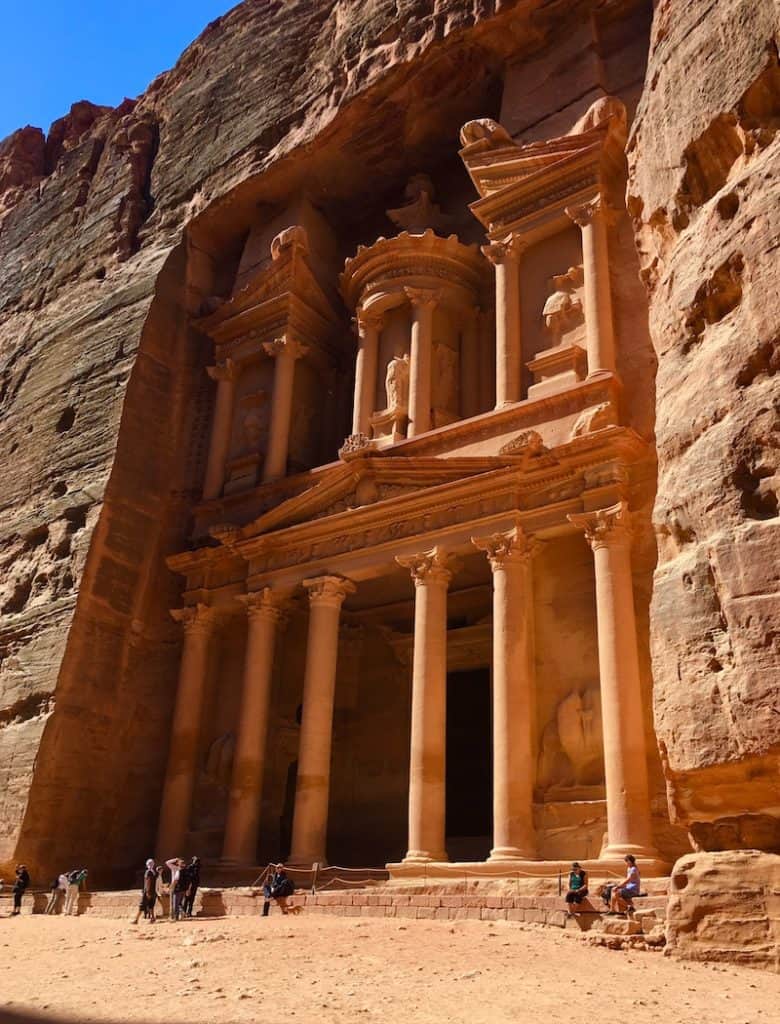
Has a movie ever inspired you to travel across the world? Back in the late 80s, I sat in a movie theater watchingIndiana Jones and The Last Crusadeand saw The Treasury for the first time. I knew I had to see it.Fast forward 30 years I found myself walking along the Siq, 10,000 miles from home. Standing in the shadow of The Treasury, chills covered my body.I felt a little like Indiana myself, dusty and dressed for adventure. Here’s my top tips for visiting Petra.
What’s Petra
Petra is actually the Petra Archaeological Park that includes 264,000 acres. The iconic building most visitors associate with Petra is called the Treasury. And it’s one of the Seven Wonders of the Modern World and a UNESCO World Heritage Site.
Built at the crossroads of the Arabic, Egyptian and Syrian-Phoenician trade routes, the Nabataeans carved a city of elaborate facades out of solid sandstone. The exact date of construction in unknown though could be as early as the 4th century B.C.
As a symbol of trading wealth Petra flourished though abandoned by 700 AD. Petra remained a secret only known to a few animal herders for centuries.
It was rediscovered by a Swiss Explorer in 1812. Steven Spielberg and Harrison Ford filmed the Indiana Jones movie there in the late 1980s.
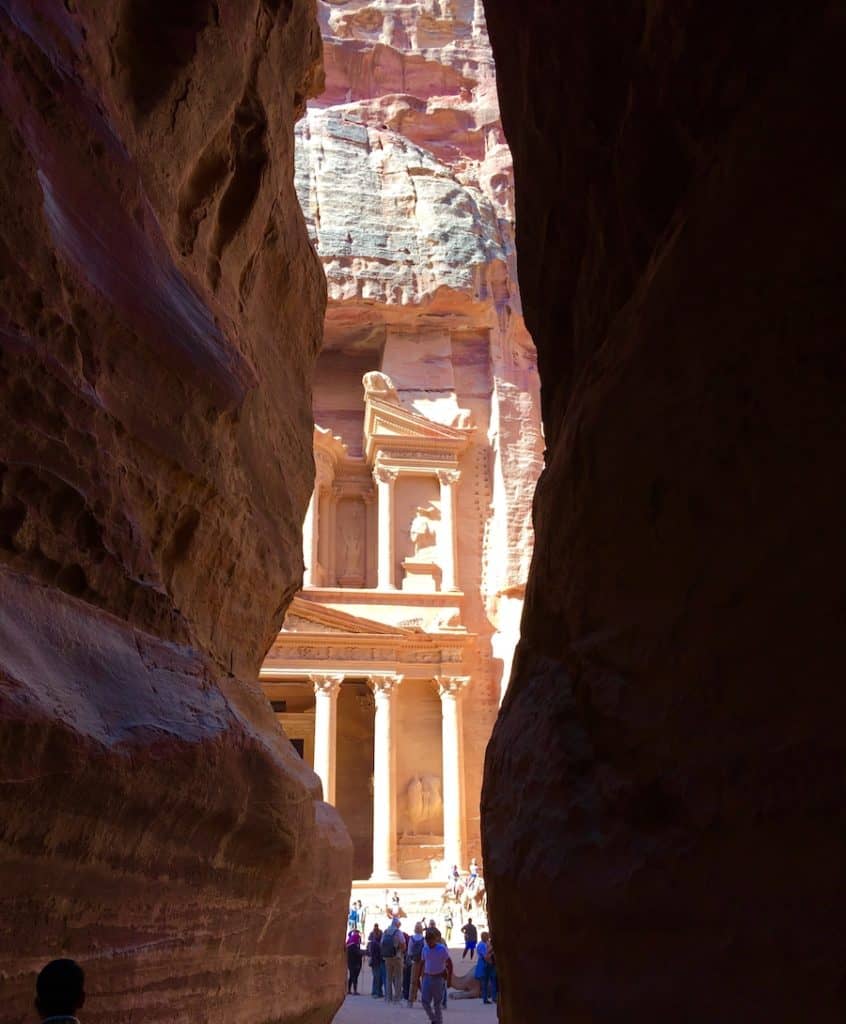
Why is Petra Special
South of the Dead Sea and north of the Red Sea, the mountainous area that surrounds Petra was a trade route. The native people were Arabic nomads or Bedouin, called the Nabataeans. They controlled a network of oases vital for survival.
As a result, the Nabataeans prospered and began to built monuments and tombs to demonstration their wealth. The exact date of Petra’s constructionis unknown though thought to be as early as the 4th century BC. During the 1st century at the height of the Nabataean culture, 20,000 people lived in the area.
The Romans conquered the area in 106 AD and the area declined soon after. The trade route changed as water routes were used more than overland routes.
Petra was lost for more than a thousand years. Known only to local Bedouin who herded animals in the area.
Then in 1812, a Swiss Explorer rediscovered Petra when the local Bedouin showed him the fabled lost city. In 1839 a Scottish painter sketched the area and returned to Britain with tales of the local Bedouins.
In 1917 British Officer T.E. Lawrence, or Lawrence of Arabia, helped to lead the Arab Revolt against the Ottoman Empire through the area around Petra. Eventually pushing the Ottomans out in Aqaba, at the Red Sea.
Interest surged in the area and in 1929 four scholars excavated and surveyed Petra. Two British scholars along with a folklore expert from Palestine conducted the study.
In 1985 the United Nations designated Petra a UNESCO World Heritage Site, ushering in the age of tourism. In 2007, Petra was declared one of the Seven Wonders of the Modern World, along with the Great Wall of China and Machu Picchu.

Top 15 Places to See at Petra
The Bab Al Siq or Gateway to the slot canyon—If it’s your first visit, walk through along The Siq
The Dam—The Nabataeans were masters at rainwater collection and flash flood water diversion. With the construction of the dam, the Nabataeans protected the temples in Petra.
The Siq—A narrow gorge, or slot canyon, is the dramatic gateway to The Treasury. For your first trip to Petra enter along the Siq for a movie moment reveal.
The Treasury—The national symbol of Jordan to most of the world. A hand-carved rock façade that the Nabataeans constructed from the top down.
The Street of Facades—More to see than the Treasury. Walk along the street to see rock facades of the Nabataean tombs.
High Place of Sacrifice—High above the Street of Facades, the rock façade was used for religious ceremonies.
The Theatre—It looks Roman but the Nabataean carved the theatre into the rock instead of stacking rock to construct the area.
The Royal Tombs—Four side-by-side tombs including the Urn, Silk, Corinthian and Palace Tomb
The Nymphaeum—Along the original Colonnaded Street, find the ruins of a semi-circular public fountain. Used as a shopping district in ancient Petra, this area is still the main through fare.
The Colonnaded Street—Originally built by the Nabataeans, then the Romans refurbished the street during their occupation.
The Church—Built by the Byzantines in the 5th century AD and destroyed by fire and earthquakes.
Great Temple—One of the major architectural monuments in Petra and a sacred site
Qasr al-Bint—A square monument dedicated to Dushara, an important Nabataean god. A flight of 23 marble stairs leads to the monument.
The Lion Triclinium—Two lions decorate the outside of this chamber.
The Monastery—The largest monument in Petra atop nearly 1,000 steps. Built during the reign of King Rabel II. Used as a Christian church later and how it got its name.
More than The Treasury
My first wow moment was the big reveal of The Treasury along The Siq. I felt like Indiana Jones in my dusty dungarees seeing it for the first time.
With an audible wow, a journey of a lifetime settles upon visitors standing in its shadow. For the best experience, see The Treasury in the soft light of the morning or afternoon, when its rose-colored hues really pop.
After studying The Treasury and taking what seems like a million photos, take the path to the right to discover the ancient city. Petra is part active archeological dig, tourist destination and thriving ancient city.
Though residents have moved to the nearby Wadi Musa (the nearby tourist town) Petra in many ways is still a thriving town. Camel handlers hawk their services. Merchants set up stalls selling souvenirs, like tiny carved camels and postcards. Tour guides lead groups explaining the significant in every imaginable language.
Take your time and spend at least one full day exploring Petra.
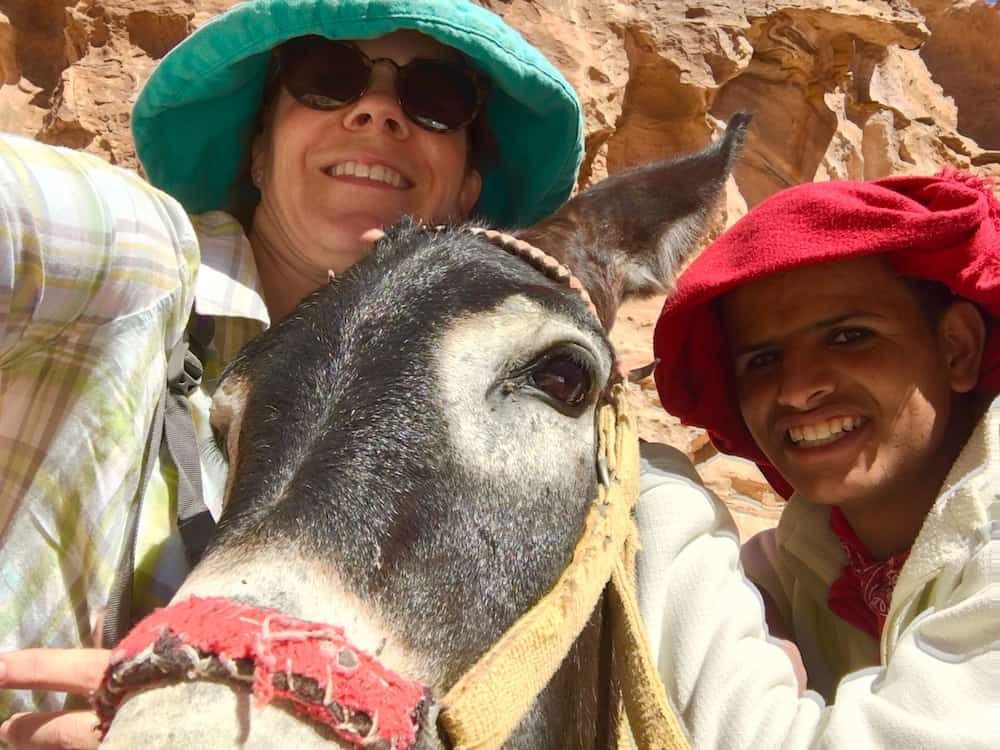
Ride a Donkey to The Monastery
Conserve your energy and take a donkey up the nearly 1,000 steps to visit the magnificent Monastery as it glows in the afternoon sun. With an experienced guide leading the way, the donkeys climb the steps on a sure-footed hoof.
Riding a donkey up 1,000 steps with a kid leading the way (I think my guide was 18) isn’t for the faint of heart. A combination of worn steps and shear cliffs is equal parts exhilarating and terrifying.
Though don’t miss The Monastery. Larger than The Treasury, it’s 160 feet wide and 148 feet tall. Since it requires most visitors to hike along The Siq, The Colonnaded Street and up the steps, most visitors see The Monastery in the amber light of the late afternoon.
With skies the shade of blue bird, the Nabatean Classical architectural features pop. As a reward, I enjoyed a cup of mint tea at the tea shop at the top.
Know Before You Go:For experienced riders only, not advised for small children or nervous riders. And find only a portable toilet at the top.
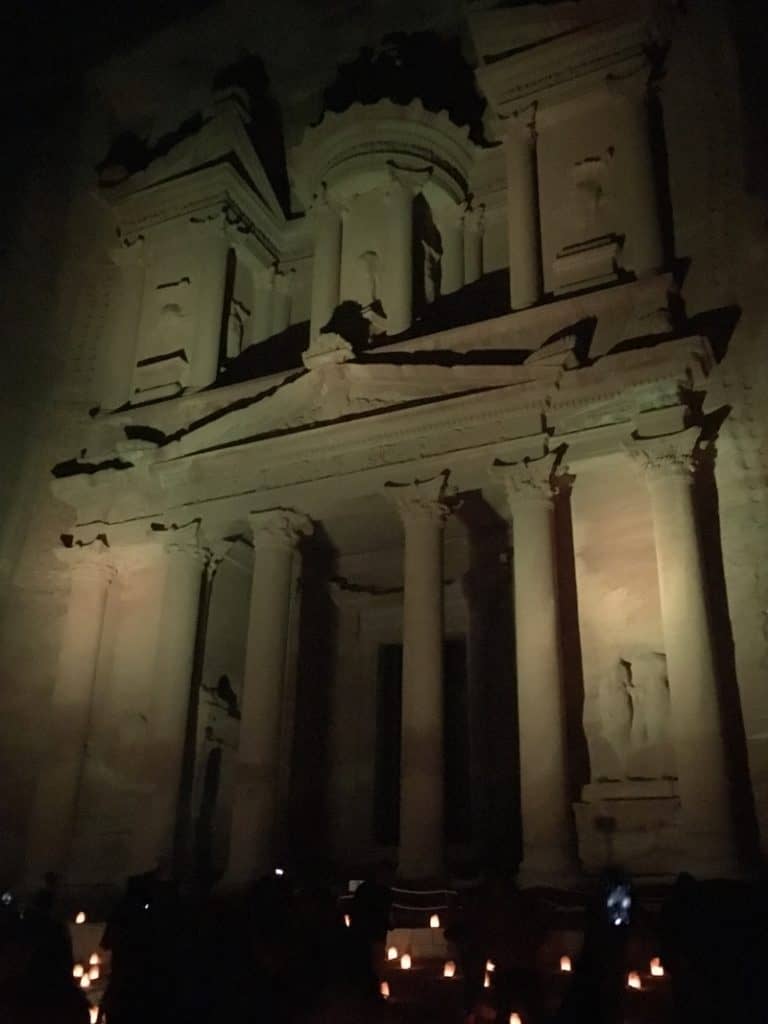
Petra-At-Night
See Petra in the amber glow of candlelight while listening to the traditional music. As I sat in the sand at the foot of The Treasury I took the opportunity to really study the monument. Maybe in an effort to remember the details for a lifetime.
Petra in the veil of candlelight is magically, though it’s not a substitute for exploring during the day. If you have limited time in Petra, don’t try to do both on the same day.
Petra-at-Night is an additional ticket, 17JD (Jordanian Dinar) for adults and kids under 12 are free. Purchase tickets at the visitor center. Gates open at 8:30 p.m. and the program lasts for two hours. Bring a flashlight, the Siq is dark in places.
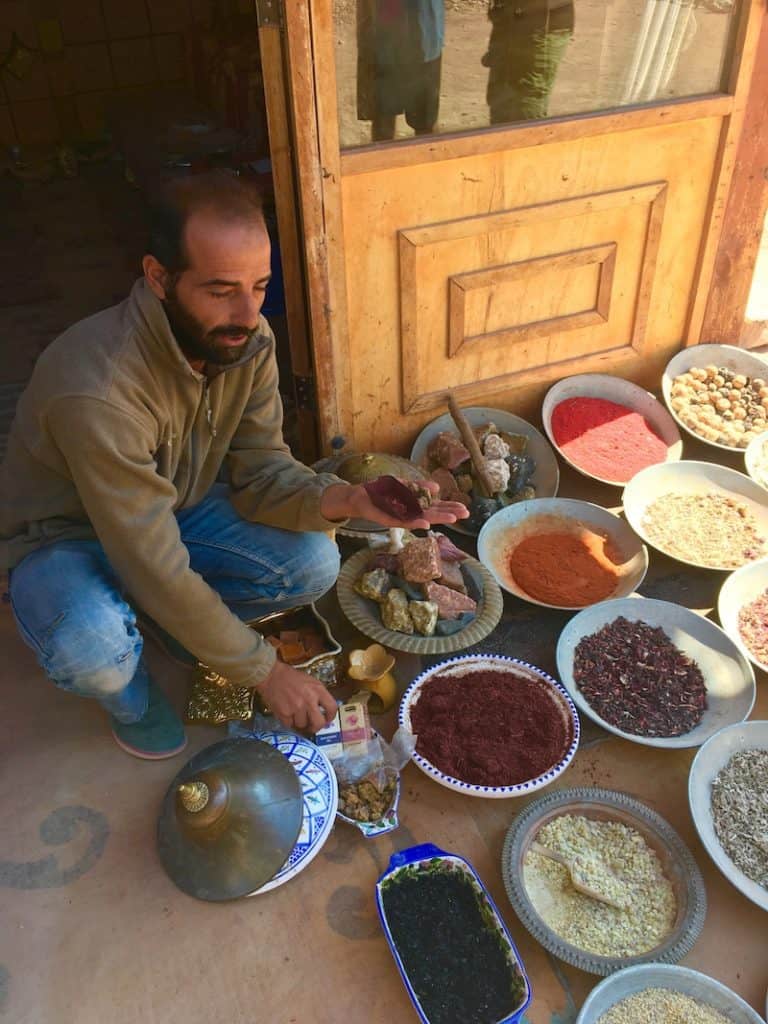
Shopping in Petra
During my visit, I picked up some souvenirs. I recommend the personalized sand bottles for kids. Artisans will add their name to a traditional bottle of sand art.
Take home a taste of Jordan, I bought Jordan’s national spice, Za’atar. A proprietary mixture though most blends include, thyme, oregano, marjoram, sesame and salt.
I found several merchants selling scarves or bracelets. Though if not interested in their wares, a simple thank you works to get them to walk on.
How Many Steps?
Count those steps, it might be the top day of your trip. The steps add up quick so if you or someone in your group has mobility concerns, consider hiring a horse cart.
During my visit, I walked from Petra’s entrance through The Siq all the way to The Basin Restaurant. Then I hired a donkey to ride up the nearly 1,000 steps to The Monastery. I walked back down.
Donkeys and camels can be hired at any point along the way. I recommend it for adults and older kids, especially if you are visiting Petra in one day.
Details for Visiting Petra
The Petra Archaeological Park includes 264,000 acres. A ticket is required to visit and if you stay in Jordan for at least one night, a discounted ticket is available.
Petra is open every day. Summer hours are from 6 a.m. to 6 p.m. Winter hours are from 6 a.m. to 4 p.m.Kids under 12 are free.
Petra Tickets
| One Day Ticket | 50JD |
| Two Day Ticket | 55JD |
For visitors touring Petra without a Jordan hotel stay (cruise passengers) the admission is 90JD.
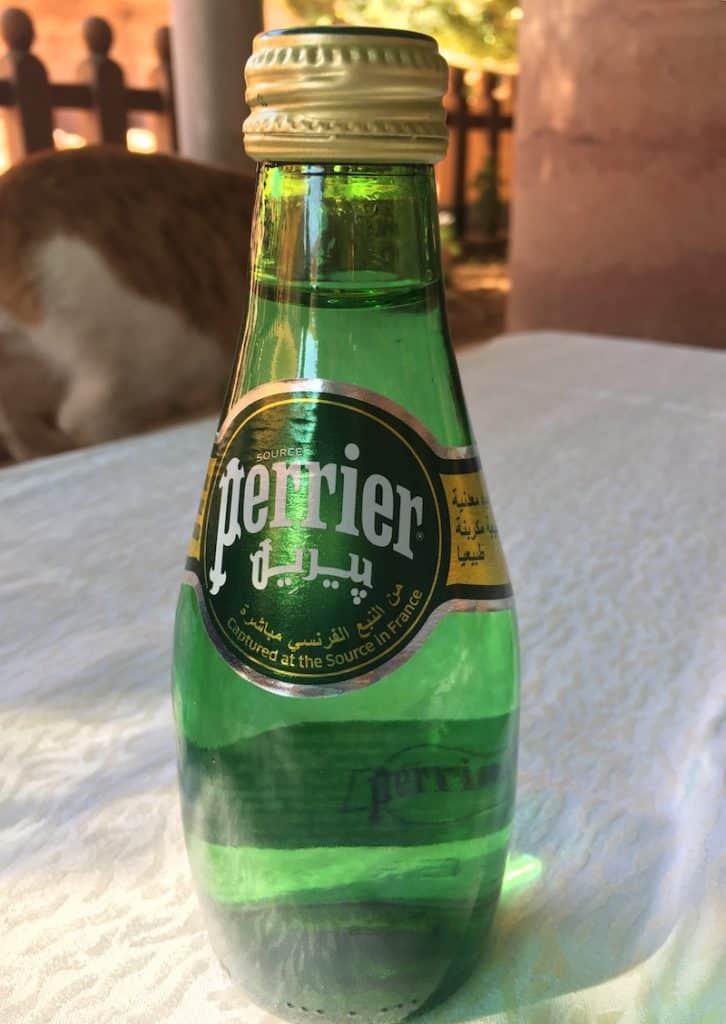
Where to Relax
Heard of a hammam, or Turkish Bath? Take an hour and enjoy a ritual brought to the Middle East by the Romans. The Petra Marriott Hotel features a spa where bathers enjoy a series of steam rooms.
After disrobing in a western changing room complete with lockers, I entered the warm room. In tiled rooms with benches on all sides, bathers sit and breath in the steam. Decompress and then move onto the hot room, where I instantly started to sweat, releasing toxins from my pores.
Finally, my masseuse guided me to a bathing room where I climbed onto a stone slab. She poured soapy water infused with moisturizers over me then took a loofa to my skin. After scrubbing my skin vigorously, she revealed a newer, softer me.
After rinsing I enjoyed a massage before returning to the steam room. I recommend this after a long day of hiking and best enjoyed with a group of friends.
Where to Stay in Petra
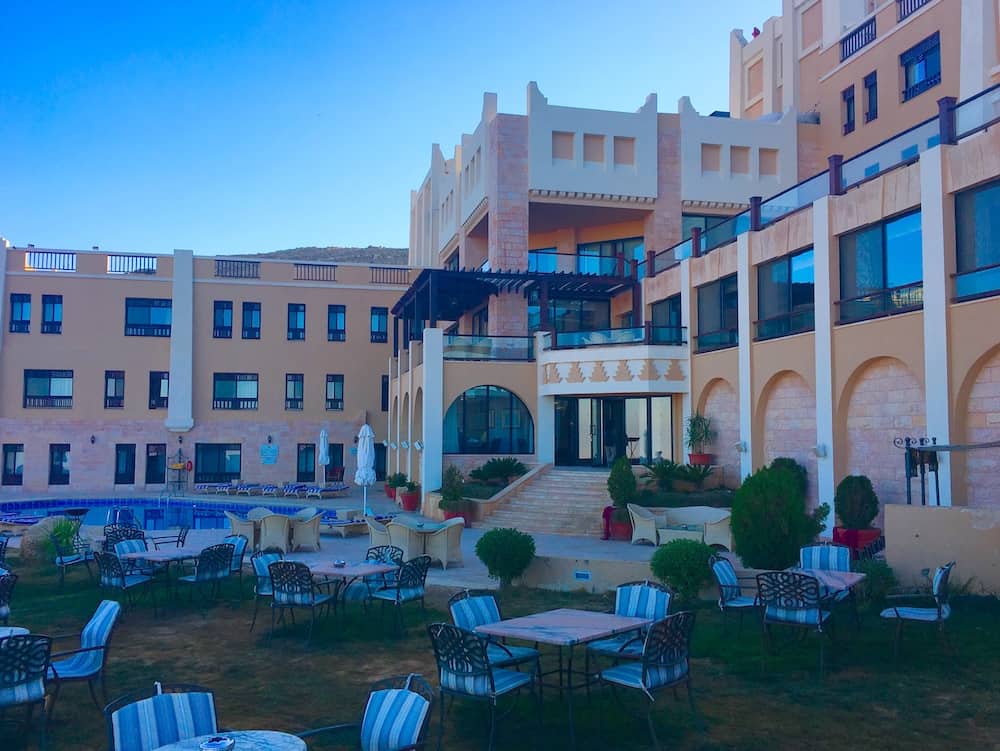
During my visit, I stayed at the Petra Marriott Hotel. With a view of the desert and extensive breakfast buffet, it exceeded my expectations for lodging in the Middle East.
With rooms appealing to a western traveler, I found all the comforts a Marriott room, including western bathrooms, in-room safes and in-room beverage service.
Located on Queen Rania Al Abdallah Street, the Petra Marriott Hotel requires a ride to the gates of the ancient city of Petra.
During my stay, I ate at the Dushara Restaurant for its breakfast buffet. And in the evening enjoyed a sunset cocktail on the back balcony overlooking the mountains.
Where to Eat in Petra
During my visit I ate breakfast at the Marriott’s Dushara Restaurant, offering a wide selection of Arabic and Western options.
For lunch, I dined at The Basin Restaurant along the Colonnaded Street in Petra. I enjoyed a table outside on the shaded patio though indoor dining is available. It offers a buffet of Middle Eastern classics along with dessert.
For dinner, I dined at the Movenpick Resort Petra’sAl Saraya Restaurant. With an extensive daily buffet, I found Western, Asian and Arabian entrees for dinner. Conveniently located across from the entrance of Petra, the Movenpick offers a place to dine before walking to Petra-at-Night.
For drinks including cocktails, visit the Cave Bar, located next to the entrance of Petra. It’s a bar carved into rock that serves cocktails, Arabic coffee and Mint Tea.
Prep and Pack Jordan
- Wear comfortable shoes, like hiking boots or athletic shoes. Hiking is required.
- Bring a hat and wear clothing to protect your skin from the sun.
- Carry local currency for camel or donkey rides. Tips for the restroom attendant are appreciated.
My trip is probably like your trip.
I explored Jordan for eight days with a full travel day on both ends. I visited Jordan in late October though you could use my packing list for spring too. Both are the high seasons for the area. With winter’s bitter temperatures and the summer’s brutal heat, I would avoid those seasons. For more tips, including how to avoid TD, head over to my Prep and Pack Jordan.
Disclosure: Consideration for brands mentioned. And this post contains affiliate links.
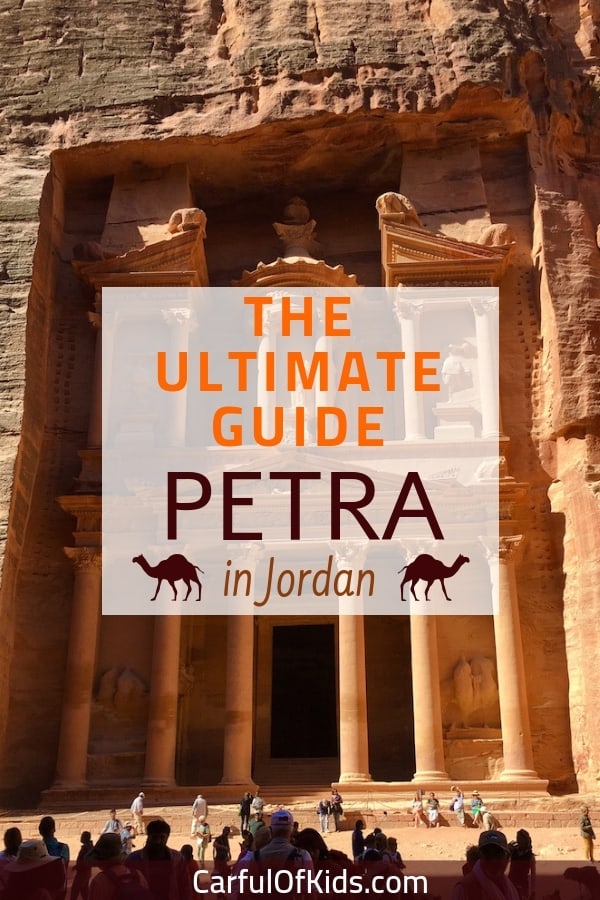



Comments are closed.